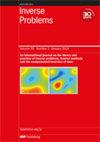Restoring the discontinuous heat equation source using sparse boundary data and dynamic sensors
IF 2
2区 数学
Q1 MATHEMATICS, APPLIED
引用次数: 0
Abstract
This study focuses on addressing the inverse source problem associated with the parabolic equation. We rely on sparse boundary flux data as our measurements, which are acquired from a restricted section of the boundary. While it has been established that utilizing sparse boundary flux data can enable source recovery, the presence of a limited number of observation sensors poses a challenge for accurately tracing the inverse quantity of interest. To overcome this limitation, we introduce a sampling algorithm grounded in Langevin dynamics that incorporates dynamic sensors to capture the flux information. Furthermore, we propose and discuss two distinct dynamic sensor migration strategies. Remarkably, our findings demonstrate that even with only two observation sensors at our disposal, it remains feasible to successfully reconstruct the high-dimensional unknown parameters.利用稀疏边界数据和动态传感器恢复不连续热方程源
本研究的重点是解决与抛物线方程相关的逆源问题。我们依靠稀疏边界通量数据进行测量,这些数据是从边界的有限部分获取的。虽然利用稀疏边界通量数据可以实现源恢复,但有限数量的观测传感器对准确追踪感兴趣的逆量构成了挑战。为了克服这一限制,我们引入了一种基于朗之文动力学的采样算法,该算法结合了动态传感器来捕捉通量信息。此外,我们还提出并讨论了两种不同的动态传感器迁移策略。值得注意的是,我们的研究结果表明,即使只有两个观测传感器,我们仍然可以成功地重建高维未知参数。
本文章由计算机程序翻译,如有差异,请以英文原文为准。
求助全文
约1分钟内获得全文
求助全文
来源期刊

Inverse Problems
数学-物理:数学物理
CiteScore
4.40
自引率
14.30%
发文量
115
审稿时长
2.3 months
期刊介绍:
An interdisciplinary journal combining mathematical and experimental papers on inverse problems with theoretical, numerical and practical approaches to their solution.
As well as applied mathematicians, physical scientists and engineers, the readership includes those working in geophysics, radar, optics, biology, acoustics, communication theory, signal processing and imaging, among others.
The emphasis is on publishing original contributions to methods of solving mathematical, physical and applied problems. To be publishable in this journal, papers must meet the highest standards of scientific quality, contain significant and original new science and should present substantial advancement in the field. Due to the broad scope of the journal, we require that authors provide sufficient introductory material to appeal to the wide readership and that articles which are not explicitly applied include a discussion of possible applications.
 求助内容:
求助内容: 应助结果提醒方式:
应助结果提醒方式:


